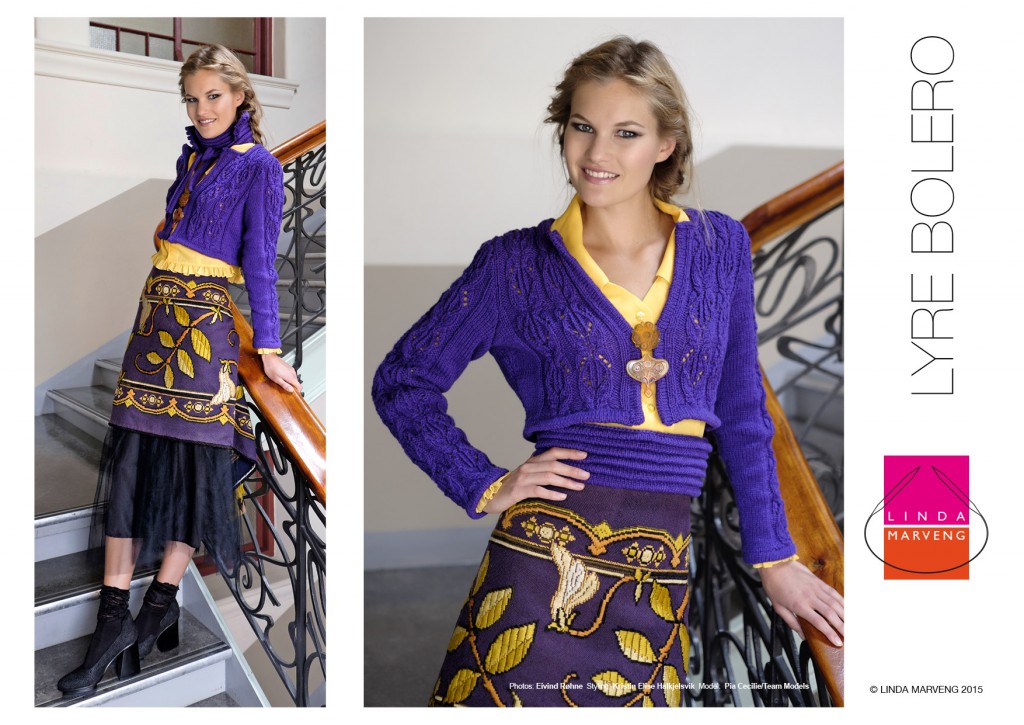 The Lyre Bolero was part of the Jugend Love series I designed for Made by Me, and Kristin Elise Halkjelsvik of Makeløs/Remarkable styled it with a hand embroider table cloth as a skirt, it was stunningly worn by Pia Cecilie/Team Models with beautiful hair & make up by Janne Skarpeid Hermansen and shoes by Monica Stålvang, all brilliantly captured by photographer Eivind Røhne. The bolero inspired test knitters to make it longer with cables or ribbing as a hem or attaching the belt and use it as a wide hem. See some of the different version on the pattern page on Ravelry where it is now available for sale in English. Here is my introduction to the pattern:
The Lyre Bolero was part of the Jugend Love series I designed for Made by Me, and Kristin Elise Halkjelsvik of Makeløs/Remarkable styled it with a hand embroider table cloth as a skirt, it was stunningly worn by Pia Cecilie/Team Models with beautiful hair & make up by Janne Skarpeid Hermansen and shoes by Monica Stålvang, all brilliantly captured by photographer Eivind Røhne. The bolero inspired test knitters to make it longer with cables or ribbing as a hem or attaching the belt and use it as a wide hem. See some of the different version on the pattern page on Ravelry where it is now available for sale in English. Here is my introduction to the pattern:
Delicate lyres made by lace and cables stitches used in panels surrounded by stocking stitch makes this bolero perfect to use on top of a wide dress or skirt on a cold day. Lyre Bolero is fitted and begins just above the waist with increases to the bust. Worked in parts to add stabilizing seams, but with long sleeves worked in the round. A stunning cummerbund made of tucks adds length and elegance.
Sizes: XS (S, M, L, XL, 2XL)
Finished Measurements: Bust: 84 (91, 98, 106, 116, 126) cm/34 (35.75, 38.5, 41.75, 45.75, 49.5)” Waist: 65 (72, 79, 87, 93, 113) cm/25.5 (28.25, 31, 34.25, 36.5, 44.5)” Length: 37 (38, 40, 42, 44, 46) cm/14.5 (15, 15.75, 16.5, 17.25, 18)”
Sleeve length: 49 (50, 50, 51, 51, 52) cm/19.25 (19.75, 19.75, 20, 20, 20.50)” Cummerbund: Tuck lengths: 69 (76, 83, 91, 97, 118) cm/27.25 (30, 32.75, 35.75, 38.25, 46.5)” Tie length: 25 cm/9.75″ Height: 9 cm/3.5″
Yarn: Hifa, Embla – Hifa 3 (100% wool, 100 g, 210 m/229 yds). Sample is knitted in Dark Blue Purple 6078. http://www.ull.no Bolero: 3.5 (3.5, 4, 4.5, 5, 5.5) skeins; 672 (735, 798, 872, 966, 1060) m/734 (803, 873, 954, 1056, 1159) yds Cummerbund: 1.5 (1.5, 1.5, 1.5, 2, 2) skeins; 231 (252, 273, 305, 315, 389) m/252 (276, 299, 333, 343, 425) yds
Yarn alternative: Cascade, 220 (100% Peruvian Highland Wool, 100 g, 201 m/220 yds). http://www.cascadeyarns.com Berroco, Ultra Alpaca (50% Wool, 50% Alpaca, 100 g, 197 m/215 yds) http://www.berroco.com/yarns/berroco-ultra-alpaca Madeline Tosh Pashmina Worsted (75% Merino, 15% Silk, 10% Cashmere, 100 g, 192 m/210 yds. http://madelinetosh.com/store/index.php/yarns/psh-worsted.html Or another worsted/10 ply yarn.
Needles: 2 sets of 4 mm/US 6 circular needle (80 cm/32″) for sweater and cummerbund. 4 mm/US 6 DPNs or circular needle for magic loop method.
Notions: Cable needle. 6 stich markers: 2 for sides, 4 for pattern. 6 stitch holders. Yarn needle.
Gauge: 21 sts and 25 rows in Lyre Pattern measures 10 cm/4″ square. 19 sts and 25 rows in st st measures 10 cm/4″ square. Adjust needle size as needed to match gauge.
Notes: The bolero is worked flat in pieces, while the sleeves are worked in the round. Discontinue the Lyre Pattern and continue in st st when dec. The cummerbund can easily be adjusted to your waist measurement by adding or detracting stitches to the numbers given; the tucks are made to meet but not overlap. The ties are added on the width of the last hem.

Love the color you chose! Just this morning I learned this about the color purple from the folks at Handwoven magazine: “BeWeave It!
“True royal purple, also known as Tyrian purple, was first discovered by the Minoans of Ancient Crete. However, it was in Phoenicia–whose name translates as purple–that the dye became famous.”
“In much of ancient Europe, purple dyes were rare, hard to make, and expensive, so only the rich and powerful could afford them. Wearing the color purple was an advertisement of social status and Roman laws restricted its use. Only the emperor and statues of the gods could wear trabea, togas dyed entirely in purple. In Byzantium, the color was similarly limited to the imperial family.”
“This highly coveted dye comes from a not-so-lofty source: the mucus secretions of predatory sea snails. It takes thousands of snails to dye even a small piece of cloth. Fortunately for us, there are cheaper–and easier to collect–natural and synthetic purple dyes, making the color of kings available to everyone.”
Thank you so much, Karen! I am delighted that you shared so much knowledge about the color purple!
Correction: it was from weaving today.com.
That is good to know, thank you!